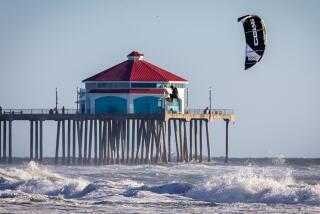$10 Million in Crops Lost From Blast of Cold Weather
- Share via
Freezing temperatures randomly wiped out entire crops and frostbit others during a three-day assault of arctic air that hit San Diego harder than any other county in California. Early estimates put losses at more than $10 million, and the damage may set back cultivation for two years.
Temperatures that dropped into the 20s--and reached a countywide low of 17 degrees in Bonsall--froze avocados, oranges and tomatoes and blackened flower and fruit buds. Growers said the damage from the freezing temperatures Thursday, Friday and Saturday nights was the worst since 1949.
Growers were beginning to assess the damage Monday, but the full results of the frost will not be determined for several days, or even weeks. Charles Woods, executive secretary of the San Diego County Farm Bureau, said the damage would be substantial.
“I think you are going to see several million dollars in avocado damage and as high as 10 million countywide for all crops. And I personally think that is a little on the conservative side after looking around this morning,” he said. San Diego County is the biggest avocado-growing county in the United States. “We normally have over a half-billion dollars in gross sales,” Woods said.
Victor Varvel, general manager for Henry Avocado Packing Corp. in Escondido, predicted a 10% to 20% loss on a “tremendously large” avocado crop.
“There are some fairly large acreages hit, upwards of 50- to 60-acre groves that don’t have much left at all,” he said.
“We have what we think is a 500-million-pound crop on the trees right now, so that’s 50 or 60 million pounds of fruit affected.”
The damage, Varvel said, may extend to subsequent crops. “Groves that are severely damaged won’t have any crop next year; it will be 1989 before we see one,” he said.
Woods agreed: “Next year we are going to have a very small crop.”
Varvel said his crews had stopped picking while damage was assessed. “A lot has been damaged beyond salability, but some may have only suffered stem damage and could be salvaged,” he said.
“Most of the mature citrus lemons in our area came through, but the fruit that was just coming on will ultimately fall. The crop has been set back. The olive, to bud-size stage, has been affected,” Roger Hill, manager of the Fallbrook Citrus Packing Co., said. “For some, the summer crop won’t materialize.”
Citrus groves were also hard hit. “Some of the citrus, the young shoots, look like they were hit by a blowtorch,” Woods said. “Citrus trees with mature fruit that I looked at appeared to show significant damage. Some will be so severely hit they won’t even be good for juice.”
He said some fresh-market tomato crops were devastated, but most crops survived.
The California Farm Bureau in Sacramento reported that early assessments indicated San Diego County received the most damage in Southern California. Other counties with agricultural damage include Ventura and Tulare.
There were reports that some young trees in San Diego County had been killed, but most of the 4,000 commercial groves in the county survived, Woods said.
“Some of the smaller growers who are just getting started may have lost trees and may think twice about replanting,” Woods said. “But I don’t think we are going to lose any commercial growers.
Unlike most frost attacks, this onslaught of cold air did not just settle in low-lying areas. To some, the damage appeared random and fueled superstitious talk about bad luck.
Crops in some normally susceptible areas, such as canyons, were not damaged, while some high-ground groves were devastated. Others remained unscathed.
“The ones that got hurt won’t talk about it, but some lost 100% and nothing happened to others,” Varvel said.
Growers were consistently reluctant to talk about damage. “Everybody likes to talk about good luck, but nobody likes to talk about bad luck,” Gary Barlow of ECO Farms in Bonsall said. “The frost didn’t fall in any real pattern. Some places that you wouldn’t think did get it and some low-lying areas didn’t.”
Woods said growers had become complacent in the years of moderate temperatures. “We have had such good weather for nearly 10 years that we kind of get upset when it goes back to some kind of natural disaster,” he said. “But we have to look at it philosophically. Weather is part of farming.”
In contrast to avocado and citrus growers’ woes, pear and apple tree owners were pleased with the chilled air.
“They are an insignificant part of the agricultural economy, but the pear and apple trees are loving it,” Woods said. “The sap is all down in the roots and they are just enjoying it.”
More to Read
Sign up for Essential California
The most important California stories and recommendations in your inbox every morning.
You may occasionally receive promotional content from the Los Angeles Times.













